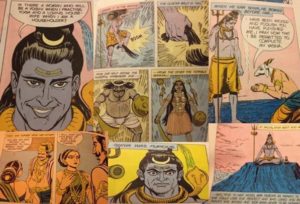We are all more than familiar with the Virabhadrasana or warrior poses. They are a part of almost every yoga class in the world. Many poses in yoga have a story attached to them, and this is one of them.
According to Indian mythology, Brahma advised Lord Shiva to get married. Shiva was an ascetic and lived in the heavens. On earth, a beautiful daughter was born to King Daksha, and she was named Sati. Even as a young girl, Sati was a staunch devotee of Lord Shiva. When she reached a marriageable age, Brahma came to visit Daksha and blessed Sati to be wed to the mighty Lord Shiva, so that she would be his only female companion. Sati began performing severe penances in order to win over Lord Shiva as her husband. Her whole being was concentrated on Shiva and nothing else.
Meanwhile in heaven, the Gods were impressed with Sati’s devotion. They approached Lord Shiva to accept Sati as his wife, and after some thought, he agreed to marry her. The couple were married with the blessings of all. They held a grand yagna (religious ceremony) in Daksha’s kingdom. When Daksha entered the ceremonial ground everyone, except Lord Shiva, stood up and bowed to him (Lord Shiva was superior to Daksha and did so to protect him). However, Daksha misunderstood and considered it as an insult and swore to take revenge on Lord Shiva.
He planned a grand yagna and invited Gods from all the three worlds, deliberately leaving Shiva and Sati out. Sati found out and wanted to go anyway. Shiva tried to convince her not to go since they were deliberately left out by Daksha. Sati ignored Shiva’s words and went to attend the yagna. Daksha humiliated and taunted Sati at the yagna, and the father and daughter got into a huge argument. Sati was deeply hurt that the one person she relied on had turned against her. She could no longer bear any more insults and declared that she would cast off her body since it was the only thing that tied her to him. She meditated intensely and increased the fire within her so much that she burst into flames in front of everyone.
Shiva’s attendants, who were waiting outside, heard all that happened and started a fight. They were, however, defeated because of Sage Bhirgu and his powerful demons whom he called upon to fight Shiva’s attendants. A terrible fight ensued between the two and Shiva’s attendants had to retreat.
Shiva was furious, he plucked out a cluster of his hair and dashed it to the ground. It split into two and one half became the powerful Virabhadra and the other half the fierce goddess Kali. Lord Shiva commanded Virabhadra and Kali to destroy the sacrifice conducted by Daksha. When Virabhadra came to the site, he entered through the earth with both his swords facing upwards and hence became Virabhadrasana 1. He then assumed a threatening stance against Daksha and all around, which is Virabhadrasana 2; and when he finally beheaded Daksha he became Virabhadrasana 3.
Virabhadra threw Daksha’s slain head into the ceremonial fire. Lord Shiva arrived at the site and was saddened by all of the bloodshed he saw. Though he had grief in his heart, he transformed it into compassion and decided to bring Daksha back to life as he had already learned his lesson about humility and pride.
Shiva found the head of a goat and brought Daksha back to life. Daksha bowed and surrendered himself to Lord Shiva and was allowed to complete the yagna that he had started. Lord Shiva went into meditation until Sati, true to her word, was reborn as Parvati to Himavan, a father whom she deeply loved and respected. She wooed and won Shiva and the two lived and loved happily ever after.
That is the story of Virabhadrasana. The next time you do this pose, think of the great history that made this pose all that it is today. Let’s make it a habit to move away from muscles, insertions and origins, and move toward the real stories and rich history that makes yoga special to millions of people all around the world.
Want to learn more about the mythical stories and history of yoga poses? Come to the Asana Pronunciation & Mythical Stories workshop this Sunday, November 8th, from 1-3pm at Aham Yoga, and you’ll hear about this and more! To sign up, click here.


